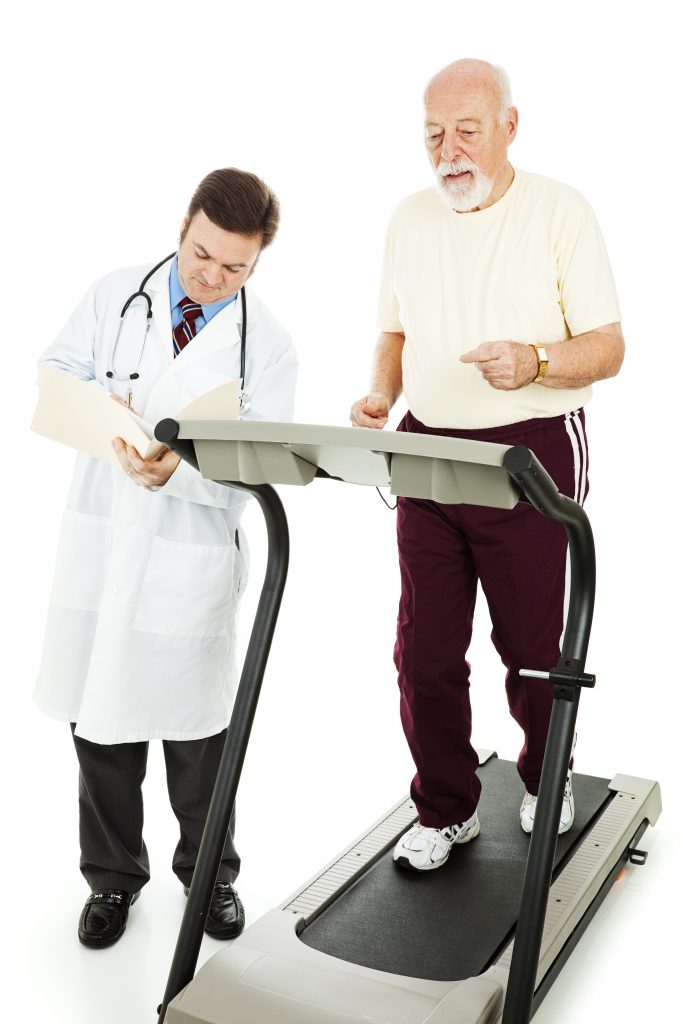What is an exercise stress test?
An exercise stress test (EST) is an ECG performed under conditions of gradually increasing physical exercise.
The ‘stress’ placed on the heart and cardiovascular system by running on a treadmill or pedalling an exercise cycle may reveal changes on the ECG to suggest coronary artery disease (angina).
How is an EST test performed?
Undergoing an EST involves exercising to the maximum effort possible for that individual.
The test is performed in a specialised laboratory where an experienced doctor (often a cardiologist) supervises the procedure.
The patient is attached to ECG leads which continuously record the heart’s electrical activity. Usually a treadmill is used to exercise the patient, with gradually increasing difficulty, to achieve the highest possible workload.
Frequent blood pressure and pulse measurements are taken during the exercise, and continuous ECG recording will detect any evidence of heart muscle ischaemia (where the oxygen demand of the heart muscle is greater than the oxygen supplied by the blood flow to the heart muscle).
The test is stopped when maximal workload is reached, or if ECG changes suggestive of angina occur, or blood pressure decreases. Equipment and staff for a full resuscitation are usually available in case of any adverse events.
Get on top of your general health
Find and instantly book affordable GPs within Australia
When would you need an EST test?
An EST is often requested by a GP, emergency physician or cardiologist in cases of chest pain where the cause is not certain.
Symptoms of shortness of breath on exertion, waking up in the night with severe breathing difficulty (paroxysmal nocturnal dyspnoea or PND), or ankle swelling may all be due to heart failure, where the heart’s ability to pump is impaired.
Heart failure is sometimes due to ischaemic heart disease (IHD), also known as coronary artery disease. IHD may cause chest pain (angina) or symptoms of heart failure.
[sc_fs_multi_faq headline-0=”p” question-0=”What happens in coronary artery disease?” answer-0=”Coronary artery disease happens when arteries, the vessels that carry blood, oxygen and nutrients to the heart, become damaged or diseased. This usually occurs due to a buildup of deposits containing cholesterol and other substances over time.” image-0=”” headline-1=”p” question-1=”What are arrhythmias?” answer-1=”Heart arrhythmias happen when the electrical impulses that coordinate the heart’s rhythm don’t function properly, causing the heart to beat too fast, too slowly or irregularly.” image-1=”” count=”2″ html=”true” css_class=””]
EST test results explained
The results of an EST are usually reported as either negative, positive or inconclusive.
Negative
A negative test result indicates a normal test which significantly decreases the likelihood of coronary artery disease.
Positive
A positive test result occurs where a diagnosis of coronary artery disease (IHD, angina) is definite.
Inconclusive
An inconclusive test result is usually due to non-diagnostic ECG changes, or when the test is terminated early due to exhaustion, beforemaximum heart rate or workload is reached.
Related specialists
- General Practitioner (GP)
- Cardiologist
- Emergency Physician
- General Physician
- Occupational Health Physician
- Anaesthetist
Related procedures
- Pre-operative Anaesthetic assessment
- Percutaneous Coronary Intervention (PCI)(=PTCA: Percutaneous Coronary Angioplasty – with or without coronary stent placement)
- Coronary Artery Bypass Grafting (CABG)
Related tests
- Glucose Tolerance Test
- Electrocardiogram (ECG)
- Dipyridamole-Thallium Scan (Dip-Thall)
- Echocardiogram (Echo)
- Chest X-Ray (CXR)
- Troponin
- Lipid Profile (Cholesterol Test)
Also known as
- Stress ECG
- Exercise ECG
- Treadmill test
- Cardiac stress test
- Exercise Tolerance Test
Links
A: Use HealthEngine to find and book your next GP appointment. Click on the following locations to find a GP clinic in your state or territory.
This article is for informational purposes only and should not be taken as medical advice. If in doubt, HealthEngine recommends consulting with a registered health practitioner.
All content and media on the HealthEngine Blog is created and published online for informational purposes only. It is not intended to be a substitute for professional medical advice and should not be relied on as health or personal advice. Always seek the guidance of your doctor or other qualified health professional with any questions you may have regarding your health or a medical condition. Never disregard the advice of a medical professional, or delay in seeking it because of something you have read on this Website. If you think you may have a medical emergency, call your doctor, go to the nearest hospital emergency department, or call the emergency services immediately.








